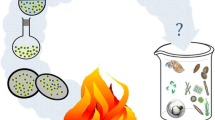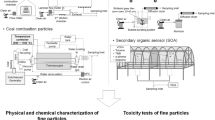Abstract
Several studies have shown that combustion-derived fine particles cause adverse health effects. Previous toxicological studies on combustion-derived fine particles have rarely involved multiple endpoints and a detailed characterization of chemical composition. In this study, we developed a novel particle sampling system for toxicological and chemical characterization (PSTC), consisting of the Dekati Gravimetric Impactor (DGI) and a porous tube diluter. Physico-chemical and toxicological properties of the particles emitted from various combustion sources were evaluated in two measurement campaigns. First, the DGI was compared with the High-Volume Cascade Impactor (HVCI) and to the Dekati Low-Pressure Impactor (DLPI), using the same dilution system and the same sampling conditions. Only small differences were observed in the mass size distributions, total particulate matter (PM), and particulate matter with diameter smaller than 1 um (PM1) concentrations and geometric mass mean diameters (GMMD) between these three impactors. Second, the PSTC was compared with the HVCI sampling system, which has been optimal for collection of particulate samples for toxicological and chemical analyses. Differences were observed in the mass size distributions, total PM and PM1 emissions, and GMMDs, probably due to the different sampling and dilution methods as well as different sampling substrates which affected the behavior of semi-volatile and volatile organic compounds. However, no significant differences were detected in the in vitro measurements of cytotoxicity between the samples collected with the PSTC and the HVCI systems. In measurements of genotoxicity, significant differences between the two sampling systems were seen only with the particles emitted from the sauna stove. In conclusion, due to compact size, PSTC is an applicable method for use in particle sampling as part of the toxicological and chemical characterization of particulate emissions from different combustion sources. It offers some advantages compared to the previously used high-volume sampling methods including compactness for field measurements, simple preparation of sample substrates and high extraction efficiency.






Similar content being viewed by others
Notes
Naphthalene, Acenaphthylene, Acenaphthene, Fluorene, Phenanthrene, Anthracene, 1-Methylphenanthrene*, Fluoranthene*, Pyrene, Benzo[c]phenanthrene, Benzo[a]anthracene*, Cyclopenta[c,d]pyrene, Triphenylene*, Chrysene*, 5-Methylchrysene, Benzo[b]fluoranthene*, Benzo[k]fluoranthene*, Benzo[j]fluoranthene, Benzo[e]pyrene*, Benzo[a]pyrene*, Perylene*, Indeno[1,2,3-cd]pyrene*, Dibenzo[a,h]anthracene*, Benzo[g,h,i]perylene*, Anthanthrene, Dibenzo[a,l]pyrene, Dibenzo[a,e]pyrene, Coronene*, Dibenzo[a,i]pyrene, Dibenzo[a,h]pyrene (Asterisks (*) indicate genotoxic PAHs)
Abbreviations
- ATCC:
-
American type culture collection
- BEAS-2B:
-
Human bronchial epithelial cell line
- BEGM:
-
Bronchial epithelial cell growth medium
- CMH:
-
Conventional masonry heater
- D a :
-
Aerodynamic diameter
- DE:
-
Non-road diesel engine
- DGI:
-
Dekati Gravimetric Impactor
- DLPI:
-
Dekati Low-Pressure Impactor
- DMSO:
-
Dimethylsulfoxide
- DNA:
-
Deoxyribonucleic acid
- ELISA:
-
Enzyme-linked immunosorbent assay
- GC-MS-SIM:
-
Gas chromatograph–mass spectrometer–single ion monitoring
- GMMD:
-
Geometric mass mean diameter
- HVCI:
-
High-Volume Cascade Impactor
- ICP-MS:
-
Inductively coupled plasma mass spectrometer
- LMA:
-
Low-melting agarose
- lpm:
-
Liters per minute
- MIP-2:
-
Macrophage inflammatory protein 2
- MTT:
-
3-(4,5-Dimethylthiazol-2-yl)-2,5-diphenyl-tetrazolium bromide
- NMA:
-
Normal-melting agarose
- OTM:
-
Olive tail moment
- PAH:
-
Polycyclic aromatic hydrocarbon
- PB:
-
Modern small-scale pellet boiler
- PBS:
-
Phosphate buffered saline
- PI:
-
Propidium iodide
- PM:
-
Particulate matter
- PM1 :
-
Particulate matter, diameter <1 μm
- PRD:
-
Porous tube diluter
- PSTC:
-
Novel particle sampling system for toxicological and chemical characterization
- PTFE:
-
Polytetrafluoroethylene
- PUF:
-
Polyurethane foam
- RAW264.7:
-
Mouse monocyte macrophage cell line
- SDS:
-
Sodium dodecyl sulfate
- SEM:
-
Standard error
- SS:
-
Sauna stove
- TNF-α:
-
Tumor necrosis factor α
- WHO-IPCS:
-
World Health Organization: International Programme on Chemical Safety
References
World Health Organization (WHO) (2003) Health aspects of air pollution with particulate matter, ozone and nitrogen dioxide: report on a WHO working group, Bonn, Germany 13–15 January 2003. World Health Organization, Regional Office for Europe, Copenhagen
U.S. EPA (2002) Health assessment document for diesel engine exhaust. U.S. Environmental Protection Agency, Washington
Boman BC, Forsberg AB, Jaervholm BG (2003) Adverse health effects from ambient air pollution in relation to residential wood combustion in modern society. Scand J Work Env Hea 29:251
Orozco-Levi M, Garcia-Aymerich J, Villar J et al (2006) Wood smoke exposure and risk of chronic obstructive pulmonary disease. Eur Respir J 27:542
Schreuder AB, Larson TV, Sheppard L et al (2006) Ambient woodsmoke and associated respiratory emergency department visits in Spokane, Washington. Int J Occup Env Heal 12:147
Andersen ZJ, Wahlin P, Raaschou-Nielsen O et al (2007) Ambient particle source apportionment and daily hospital admissions among children and elderly in Copenhagen. J Expo Sci Env Epid 17:625
Allen RW, Mar T, Koenig J et al (2008) Changes in lung function and airway inflammation among asthmatic children residing in a woodsmoke-impacted urban area. Inhal Toxicol 20:423
Mirabelli MC, Kuenzli N, Avol E et al (2009) Respiratory symptoms following wildfire smoke exposure airway size as a susceptibility factor. Epidemiology 20:451
Leonard SS, Wang SW, Shi XL et al (2000) Wood smoke particles generate free radicals and cause lipid peroxidation, DNA damage, NF kappa B activation and TNF-alpha release in macrophages. Toxicology 150:147
Barregard L, Sallsten G, Gustafson P et al (2006) Experimental exposure to wood-smoke particles in healthy humans: effects on markers of inflammation, coagulation, and lipid peroxidation. Inhal Toxicol 18:845
Kocbach A, Herseth JI, Lag M et al (2008) Particles from wood smoke and traffic induce differential pro-inflammatory response patterns in co-cultures. Toxicol Appl Pharmacol 232:317
Jalava PI, Salonen RO, Nuutinen K et al (2010) Effect of combustion condition on cytotoxic and inflammatory activity of residential wood combustion particles. Atmos Environ 44:1691
Dybdahl M, Risom L, Bornholdt J et al (2004) Inflammatory and genotoxic effects of diesel particles in vitro and in vivo. Mutat Res -Genet Toxicol Environ Mutag 562:119
Rao KMK, Ma JYC, Meighan T et al (2005) Time course of gene expression of inflammatory mediators in rat lung after diesel exhaust particle exposure. Environ Health Perspect 113:612
Bayram H, Ito K, Issa R et al (2006) Regulation of human lung epithelial cell numbers by diesel exhaust particles. Eur Respir J 27:705
Jalava PI, Tapanainen M, Kuuspalo K et al (2010) Toxicological effects of emission particles from fossil- and biodiesel-fueled diesel engine with and without DOC/POC catalytic converter. Inhal Toxicol 22:48
Pennanen AS, Sillanpaa M, Hillamo R et al (2007) Performance of a high-volume cascade impactor in six European urban environments: mass measurement and chemical characterization of size-segregated particulate samples. Sci Total Environ 374:297
Sillanpää M, Hillamo R, Mäkelä T et al (2003) Field and laboratory tests of a high volume cascade impactor. J Aerosol Sci 34:485
Demokritou P, Kavouras IG, Ferguson ST et al (2002) Development of a high volume cascade impactor for toxicological and chemical characterization studies. Aerosol Sci Tech 36:925
Lyyranen J, Jokiniemi J, Kauppinen EI et al (2004) Comparison of different dilution methods for measuring diesel particle emissions. Aerosol Sci Tech 38:12
Tissari J (2008) Fine particle emissions from residential wood combustion. University of Kuopio, Kuopio
Tissari J, Lyyränen J, Hytonen K et al (2008) Fine particle and gaseous emissions from normal and smouldering wood combustion in a conventional masonry heater. Atmos Environ 42:7862
Tissari J, Hytönen K, Sippula O et al (2009) The effects of operating conditions on emissions from masonry heaters and sauna stoves. Biomass Bioenergy 33:513
Hinds WC (1999) Aerosol technology: properties, behavior, and measurement of airborne particles. Wiley, New York
Marjamäki M (2003) Electrical low pressure impactor: modifications and particle collection characteristics. Tampere University of Technology, Tampere
Marjamaki M, Keskinen J, Chen DR et al (2000) Performance evaluation of the electrical low-pressure impactor (ELPI). J Aerosol Sci 31:249
Tissari J, Hytönen K, Lyyränen J et al (2007) A novel field measurement method for determining fine particle and gas emissions from residential wood combustion. Atmos Environ 41:8330
Jalava P, Salonen RO, Halinen AI et al (2005) Effects of sample preparation on chemistry, cytotoxicity, and inflammatory responses induced by air particulate matter. Inhal Toxicol 17:107
Jalava PI, Salonen RO, Halinen AI et al (2006) In vitro inflammatory and cytotoxic effects of size-segregated particulate samples collected during long-range transport of wildfire smoke to Helsinki. Toxicol Appl Pharmacol 215:341
Tapanainen M, Jalava PI, Mäki-Paakkanen J et al (2011) In vitroimmunotoxic and genotoxic activities of particles emitted from two different small-scale wood combustion appliances. Atmos Environ. doi:10.1016/j.atmosenv.2011.03.065
Tiitta P, Raunemaa T, Tissari J et al (2002) Measurements and modelling of PM2.5 concentrations near a major road in Kuopio, Finland. Atmos Environ 36:4057
Jalkanen L, Hasanen E (1996) Simple method for the dissolution of atmospheric aerosol samples for analysis by inductively coupled plasma mass spectrometry. J Anal At Spectrom 11:365
Lamberg H, Nuutinen K, Tissari J et al (2011) Physicochemical characterization of fine particles from small-scale wood combustion. Atmos Environ. doi:10.1016/j.atmosenv.2011.02.072
Hertel RF (1998) Selected non-heterocyclic polycyclic aromatic hydrocarbons. World Health Organization, Geneva
Mosmann T (1983) Rapid colorimetric assay for cellular growth and survival: application to proliferation and cytotoxicity assays. J Immunol Methods 65:55
Darzynkiewicz Z, Bruno S, Delbino G et al (1992) Features of apoptotic cells measured by flow-cytometry. Cytometry 13:795
Penttinen P, Huttunen K, Pelkonen J et al (2005) The proportions of Streptomyces californicus and Stachybotrys chartarum in simultaneous exposure affect inflammatory responses in mouse RAW264.7 macrophages. Inhal Toxicol 17:79
Virtanen A, Joutsensaari J, Koop T et al (2010) An amorphous solid state of biogenic secondary organic aerosol particles. Nature 467:824
Lipsky EM, Robinson AL (2006) Effects of dilution on fine particle mass and partitioning of semivolatile organics in diesel exhaust and wood smoke. Environ Sci Technol 40:155
Hytonen K, Yli-Pirila P, Tissari J et al (2009) Gas-particle distribution of PAHs in wood combustion emission determined with annular denuders, filter, and polyurethane foam adsorbent. Aerosol Sci Tech 43:442
Linnainmaa M, Laitinen J, Leskinen A et al (2008) Laboratory and field testing of sampling methods for inhalable and respirable dust. J Occup Environ Hyg 5:28
Keller CD, Bidleman TF (1984) Collection of airborne polycyclic aromatic-hydrocarbons and other organics with a glass-fiber filter polyurethane foam system. Atmos Environ 18:837
Kavouras IG, Koutrakis P (2001) Use of polyurethane foam as the impaction substrate/collection medium in conventional inertial impactors. Aerosol Sci Tech 34:46
Acknowledgments
The authors wish to thank Eng. Pentti Willman from the University of Eastern Finland for the gravimetric analysis and Terhi Penttilä M.Sc. and Annika Hukkanen M.Sc. from the University of Eastern Finland for the PAH analyses. Ms. Arja Rönkkö, Ms. Heli Martikainen and Mrs. Arja Kinnunen from the National Institute for Health and Welfare are thanked for their excellent technical assistance in toxicological studies. Mr. Vivian Paganuzzi and Ewen Mac Donald from the University of Eastern Finland are also highly appreciated for revising the language. Dekati Ltd. from Tampere, Finland, is thanked for lending out the sampling instruments. We acknowledge the Sustainable Energy Programme of the Academy of Finland and the Finnish Funding Agency for Technology and Innovation (Tekes) for funding this study.
Author information
Authors and Affiliations
Corresponding author
Additional information
Published in the special issue Aerosol Analysis with guest editor Ralf Zimmermann.
Rights and permissions
About this article
Cite this article
Ruusunen, J., Tapanainen, M., Sippula, O. et al. A novel particle sampling system for physico-chemical and toxicological characterization of emissions. Anal Bioanal Chem 401, 3183–3195 (2011). https://doi.org/10.1007/s00216-011-5424-2
Received:
Revised:
Accepted:
Published:
Issue Date:
DOI: https://doi.org/10.1007/s00216-011-5424-2




